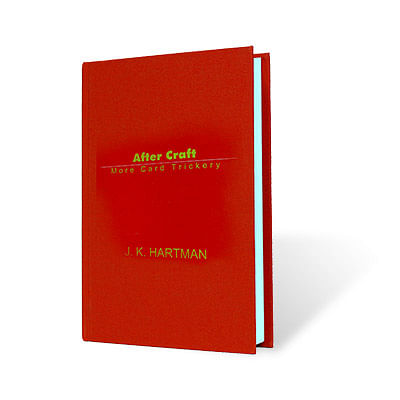After Craft by J. K. Hartman
Reviewed by Jamy Ian Swiss (originally published in Genii March, 1996)

If you loved Card Craft, J. K. Hartman's previous monolithic tome, you'll certainly be
delighted with this follow-up volume. Lighter in actual weight but no less weighty in the
substance of its contents, this is a book for lovers of card magic who want a volume that
will provide a wide-ranging menu of options and inspirations, a diverse buffet of
offerings that will continue to feed the reader for much more than a single night's read.
As is always the case, Mr. Hartman provides a tremendous variety and volume to select
from, the overwhelming mass of which falls well within the technical capabilities of the
average practitioner.
The opening segment describes nine original sleights, which are repeated from Card
Craft for the purpose of rendering this new volume entirely self-contained. These
sleights are the only material repeated from that book. Next the student will discover
twelve chapters, divided into two sections; the first section consisting of 27 additional
sleights in four chapters, followed by 59 tricks in the remaining eight chapters. Phew!
Mr. Hartman has a taste for subtle construction and an eye for uncomplicated clarity in
his effects and, perhaps especially, his sleights and finesses. Secret Subtraction is a
standard sleight today, and techniques like the Knuckle Jog have often found favor with
many card workers; a deceptively simple technique like the One Below Break (for
establishing a break one card below a card being inserted in the deck) in this volume
may well similarly spread into the collective cardician consciousness. (A few excellent
descriptions of non-Hartman sleights will also be found here, including a very useful
description of Jean-Pierre Vallarino's Rhumba Count.) While it may seem perverse to
mention a few seemingly inconsequential sleights in the face of so many tricks, I am
hard pressed to single out any of the latter. There are transpositions, sandwich routines,
assemblies, discoveries, poker deals, mental routines, and more...much more...much,
much, more...hell, you get the idea, and any trick I highlight is bound to bring objections
from those whose preferences differ. Perhaps more to the point, the book is apparently
selling well, so Mr. Hartman has his loyal audience, and you know who you are. Also, I
would point out that Mr. Hartman's influences and inspirations are often of interest;
where so many other works are stimulated by the worthy likes of Vernon and Marlo, one
is as likely or more so to come upon the names of Walton and Fulves in Mr. Hartman's
work, and these tastes can at times lend a distinctive flavor to his particular brand of
card concoction. And while there is much fodder for the student's own learning, thinking and experimentation, there is commercial material to be found, too. I
particularly liked Mr. Hartman's graceful handling and detailed presentation of the
ancient effect of pulling a card case from a spectator's hand, only to mysteriously leave
the selection remaining in his or her grip. (There, I picked one out anyway.)
The casual reader won't get much out of this book, but that's not to say that one needs to
be a passionate or possessed expert to mine its treasures. Mr. Hartman generally begins
by briefly describing the technical requirements and/or precedents of a trick, and not
the effect. Hence it is difficult to properly conceive this material without a careful
reading, playing cards in hand. Once the student embraces that approach, he or she will
find himself ably assisted by Mr. Hartman's remarkably concise prose—it is truly some
kind of accomplishment that 56 sleights and 59 tricks, along with some 700
illustrations, are contained in less than 300 pages! The descriptions are eminently
thorough and instructive, and are amply supported by the illustrations of Joseph K.
Schmidt, whose direct style is well suited to Mr. Hartman's efficient prose.
